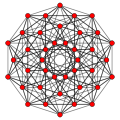Top Qs
Timeline
Chat
Perspective
Five-dimensional space
Geometric space with five dimensions From Wikipedia, the free encyclopedia
Remove ads
A five-dimensional (5D) space is a space with five dimensions.
This article has multiple issues. Please help improve it or discuss these issues on the talk page. (Learn how and when to remove these messages)
|

Remove ads
Five-dimensional Euclidean geometry
Summarize
Perspective
5D Euclidean geometry designated by the mathematical sign: 5 [1] is dimensions beyond two (planar) and three (solid). Shapes studied in five dimensions include counterparts of regular polyhedra and of the sphere.
Polytopes
In five or more dimensions, only three regular polytopes exist. In five dimensions, they are:
- The 5-simplex of the simplex family, {3,3,3,3}, with 6 vertices, 15 edges, 20 faces (each an equilateral triangle), 15 cells (each a regular tetrahedron), and 6 hypercells (each a 5-cell).
- The 5-cube of the hypercube family, {4,3,3,3}, with 32 vertices, 80 edges, 80 faces (each a square), 40 cells (each a cube), and 10 hypercells (each a tesseract).
- The 5-orthoplex of the cross polytope family, {3,3,3,4}, with 10 vertices, 40 edges, 80 faces (each a triangle), 80 cells (each a tetrahedron), and 32 hypercells (each a 5-cell).
An important uniform 5-polytope is the 5-demicube, h{4,3,3,3} has half the vertices of the 5-cube (16), bounded by alternating 5-cell and 16-cell hypercells. The expanded or stericated 5-simplex is the vertex figure of the A5 lattice, ![]()
![]()
![]()
![]()
![]()
![]()
![]() . It and has a doubled symmetry from its symmetric Coxeter diagram. The kissing number of the lattice, 30, is represented in its vertices.[2] The rectified 5-orthoplex is the vertex figure of the D5 lattice,
. It and has a doubled symmetry from its symmetric Coxeter diagram. The kissing number of the lattice, 30, is represented in its vertices.[2] The rectified 5-orthoplex is the vertex figure of the D5 lattice, ![]()
![]()
![]()
![]()
![]()
![]()
![]() . Its 40 vertices represent the kissing number of the lattice and the highest for dimension 5.[3]
. Its 40 vertices represent the kissing number of the lattice and the highest for dimension 5.[3]
Other five-dimensional geometries
Summarize
Perspective
The theory of special relativity makes use of Minkowski spacetime, a type of geometry that locates events in both space and time. The time dimension is mathematically distinguished from the spatial dimensions by a modification in the formula for computing the "distance" between events. Ordinary Minkowski spacetime has four dimensions in all, three of space and one of time. However, higher-dimensional generalizations of the concept have been employed in various proposals. Kaluza–Klein theory, a speculative attempt to develop a unified theory of gravity and electromagnetism, relied upon a spacetime with four dimensions of space and one of time.[4]
Geometries can also be constructed in which the coordinates are something other than real numbers. For example, one can define a space in which the points are labeled by tuples of 5 complex numbers. This is often denoted . In quantum information theory, quantum systems described by quantum states belonging to are sometimes called ququints.[5][6]
See also
References
Further reading
External links
Wikiwand - on
Seamless Wikipedia browsing. On steroids.
Remove ads








